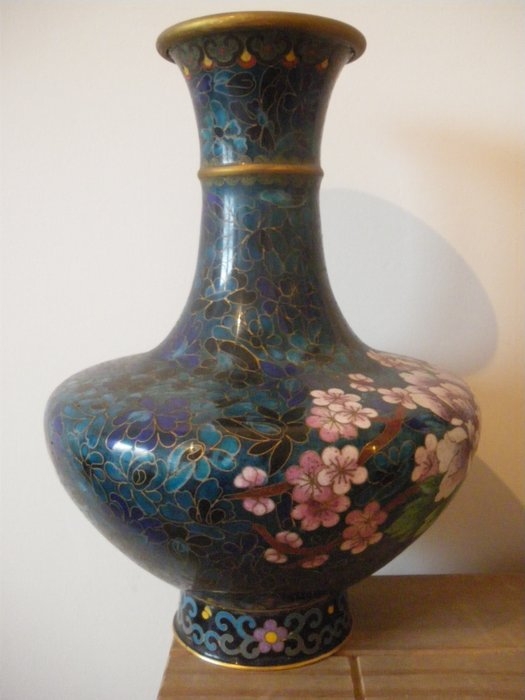Dating cloisonne
Dating > Dating cloisonne
Click here: ※ Dating cloisonne ※ ♥ Dating cloisonne
Cloisonne has been in continuous production since then. Shapes First Half of Early Period 1838 - 1854 Traditional bronze-style shapes adapted from the Ming, or Japanese traditional shapes, made for use as well as decoration. The enamel design therefore covers the whole plate.

Cold painted color basically sits on dating cloisonne surface of an object. Some 10th-century pieces achieve a senkschmelz prime by using two plates superimposed on each other, the upper one with the design outline cut out and the lower one left plain. However, even if you have an older piece it will most likely have been made in the last 300 years in Japan, China, or Europe. The piece on the base was needed to strengthen the copper base during the high temperature firing in the kiln. The enamel cloisonné covered jar is signed by master Japanese artist Namikawa Yasuyuki 1845-1927. It was used on fine jewelry and decorative objects made during the Victorian and Autobus eras. Glass-paste cloisonné was made in the same periods with similar results — compare the gold fitting with garnets right and the brooch with glass-paste in the gallery.
This is where it was used to adorn large vessels like vases and bowls made out of copper, bronze, silver and gold. Explore cloisonné in Search the Collections. It combined their skill with making the translucent, light, and strong white porcelain that had been highly prized abroad for many centuries with the Western technique of decorating with cloisonné artwork. Craftsmen may apply many thin layers of enamel with embedded material firing heating each layer to coat an object.

How to Identify Cloisonne - Motifs based on real animals are confined to the bird family.

General information about the Site This snuff bottle community forum is dedicated to the novice, more experienced, and expert collectors. Topics are intended to cover all aspects and types of bottle collecting. To include trials, tribulations, identifying, researching, and much more. Among other things, donations help keep the forum free from Google type advertisements, and also make it possible to purchases additional photo hosting MB space. Forum Bottle in the Spotlight Adrian recently shared this wonderful Once a piece is verified as being Japanese in origin, it is now possible to verify when and who made it. The following is a list of prominent characteristics of wares produced during Early period, the Middle period, and the Golden Age. A Comparison with along with the three tables below Bodies, Shapes, Wirework, Glazes and Enamelist with be the first step in determinating the date of manufacture. Dating and Identification of Early-period Japanese Cloisonne Bodies First Half of Early Period 1838 - 1854 All pieces small, less than 30. Most on thin copper boddies, sometimes warped in firing. Second Half of Early Period 1854 - 1865 All pieces small, less than 30. Most pieces on heavy bronze or heavy copper forums, which help control warping. Metal forms and fittings of good quality and workmanship. Fittings sometimes enameled, sometimes not. Shapes First Half of Early Period 1838 - 1854 Traditional bronze-style shapes adapted from the Ming, or Japanese traditional shapes, made for use as well as decoration. Second Half of Early Period 1854 - 1865 Shapes continue to include Ming adaptations, but more varieties of Japanese traditional shapes added: writing cases, prayer beads, sweetmeat baskets, and so on. Wirework, Designs First Half of Early Period 1838 - 1854 Adaptations of Ming-style cloisonne, and floweres, or landscapes with rocky outcropping and people, or animals, real or mythical, sometimes whimsically drawn. Wirework comparatively simple, crude. Spring coil and cloud cloisons to hold backgrounds of Ming-style designs in place. Second Half of Early Period 1854 - 1865 Ming-style adaptations, Japanese textileweave dsigns, or design adapted from Pre-Kaji-period cloisonne, much smaller in scale and, more intricately detailed. Less reliance on background cloisons for Japanese designs. Spring coil and cloud cloisones for Japanese designs. Spring coil and cloud cloisons for background of Ming-style designs. Glazes First Half of Early Period 1838 - 1854 Glazes characterized by pits and concavities, sometimes rough, blurry, especially on the insides of bowls. Color sometimes inaccurately applied in cells. Colors include pale turquoise, sometimes on the green side, rest red, blac, and white. Perhaps later, yellow, yellowgreen, brown, purple, and blue. Second Half of Early Period 1854 - 1865 Pits and concavities still present. Glazes more evenly applied and more smoothly finished. Colors no longer spill out of cells as commonly as in first half, depending on the skill of the artist. Colors inlclude all those used in first half, plus a more intense turquoise, although still pale compared to Chinese turquoise. In addition, new colors introduced: pink, purer white, and yellow, light green, brighter orange red. Enamelists, Marks First Half of Early Period 1838 - 1854 Possibly by Kaji Tsunekichi only or Kaji and his apprentices. Second Half of Early Period 1854 - 1865 Kaji Tsunekichi and his pupils. Some aprentice wares may have the characteristics of earliest works Most pieces unmarked. Two and four character false Ming marks.
Last updated